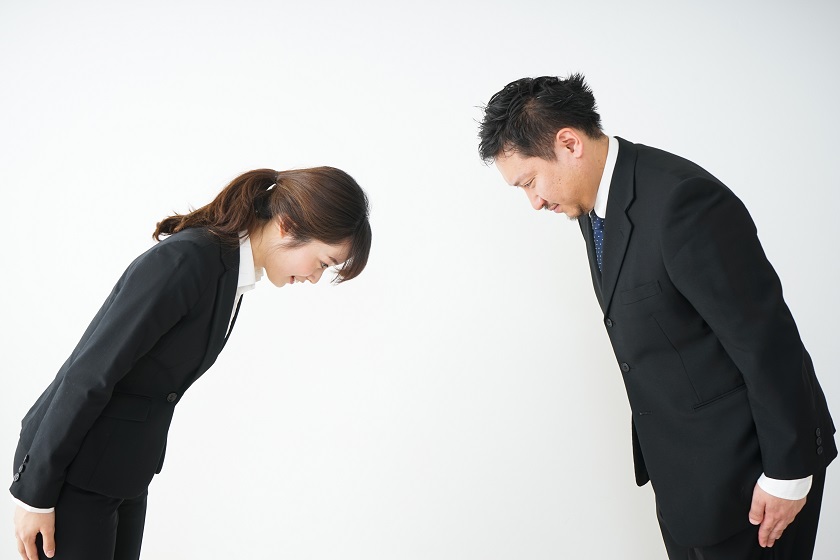Traveling to a different country for business affairs can feel like a daunting task. But it doesn’t have to be. Becoming knowledgeable about Japanese business etiquette before your big trip can ensure that the time spent there is both respectful and enjoyable. Not only will that knowledge help in adjusting to the new environment, but it will look good as well. Show your business partner that you are serious about your engagement with these following tips.
Japanese Greetings
The first part of meeting fellow businessmen or women is the greeting. Understanding the nuances to this are a necessity upon traveling to the country. Take note of the proper etiquette mentioned below:
Common Japanese Phrases
Learning a few Japanese greetings will show your business partner respect and sincerity. Simple phrases such as “hello” and “goodbye” go a long way.
Japanese Kana Pronunciation Meaning こんにちは “Konnichiwa” Hello/Good Afternoon おはようございます “Ohayōgozaimasu” Good morning こんばんは “Konbanwa” Good Evening さようなら “Sayōnara” Goodbye ありがと “Arigatou” thank you; thanks かんぱい “Kanpai” CheersPronunciation is important, so remember to practice the phrases beforehand. Listening to their translation on apps such as Google Translate can help. Don’t worry if this is all you can say. As long as you show you are making a genuine attempt, your Japanese counterparts will generally forgive your faux pas.
Bowing Etiquette

A hallmark of Japanese business etiquette is the bow. Originating from 14th-century samurai, bowing is a distinct and meaningful characteristic of Japanese culture. Traditionally thought of as samurai etiquette, the greeting has grown to find itself performed as a sign of respect in nearly every facet of Japanese business. To learn how to appropriately bow, follow these tips:
- Types of Bows – Different bows hold different meanings. Essentially, the longer and deeper the bow, the more respect is being shown. As such the bow can range from a simple nod of the head to an extensive bend at the waist.
- Specific Bowing Etiquette – It is important to keep your back straight, keep your hands at your side, and avoid eye contact.
- Handshaking – For Westerners traveling to Japan, it is important to remember this etiquette, considering that Japanese do not commonly use handshaking as a greeting. Pay attention to the body language of your business partner. Though they may go in for a handshake, do not expect it and do not initiate it. Simply follow your business partner’s lead.
Business Attire
Dress to impress. Play it safe and wear formal attire when meeting with your business partner. Further business attire tips are included below:
- For Men – A blue or black suit is traditional. Though be careful to avoid wearing a black tie — as, when worn with a black suit and white shirt, can symbolize funeral attire.
- For Women – The same formality goes. Though blue or black skirt suits are more common, pants suits are acceptable.
- Covering Up – Ensure that your skirt is not too short nor too tight. Japanese are rather conservative, so it is important to cover your skin, especially when traveling with tattoos. Wearing tights or long-sleeved clothing should suffice.
- Additional Clothing Items – Avoid open-toed shoes and excessive accessories.
- Clean Socks – In some occasions, Western guests will meet with their business partner in places such as a restaurant, that do not allow shoes. Clean and well-kept socks are important since they will not necessarily be hidden in your shoes throughout the duration of your business trip.
- Easy-to-Remove Shoes – Likewise, a pair of shoes that can be easily removed and put back on bodes well with how frequently you may be removing shoes in Japan.
Removing Your Shoes
Throughout various homes and public settings, removing your shoes is customary. Accordingly, knowing when to do so is important. For business conducted outside of the typical office space, the following tips may help.
- Homes – Remove your shoes upon entering a Japanese home. Not doing so is a sign of disrespect in Japanese culture, as well as a sure way to track dirt.
- Where To Place Your Shoes – Shoes are commonly removed outside and left on a rack or on the floor. A sign of respect is to place your shoes so they are facing towards the door.
- Slippers – On occasion, a pair of slippers may be offered when entering someone’s home. These are allowed around most of the house.
- Toilet Slippers – Such “home” slippers are not be worn when eating on tatami mats nor when in the bathroom. A separate pair of “toilet” slippers may be offered.
- Public Places – Certain public places, such as restaurants and historic buildings, require that you remove your shoes before entering. The same etiquette for Japanese homes applies here.
- Other Public Places – Removing your shoes is not necessary when traveling on public transportation. Rather, the etiquette is mostly reserved for homes, restaurants, and other cleanly or sacred dwellings.
Business Card Exchange Etiquette

Exchanging business cards is a more formal matter in Japan than it is in many Western countries. Essentially, the business card presents itself as a distinct bearer of identity in a society that prioritizes groups and social status. Therefore, be conscientious of the following protocol when meeting with your business partner:
- Business Card Case – To Japanese, the condition of your business card relays how well you conduct yourself. Don’t hand your business partner a frayed card straight out of your wallet. Japanese commonly keep their business cards within a nice case. It is respectful to do the same.
- Use Two Hands – Keep two hands on your business card when offering it to your business partner, likewise do the same when accepting theirs. Place your hands on the outside of the card so as not to block the name or other important information.
- Bow Slightly – Bowing when accepting or delivering a business card is just as respectful as it is when greeting your business partner. However, this bow should only be slight.
- Placement of Your Business Card – Place your card below your business partner’s during the exchange.
- Say Thank You – Lastly, remember to say thank you upon accepting your business partner’s card.
General Japanese Etiquette
Some additional etiquette may be needed for a successful business endeavor. Such general Japanese etiquette includes:
- Using Your Phone – The general etiquette is to not cause any disturbances. For that reason, be courteous when using your phone. Many transportation services ask that phones be placed on silent mode. Additionally, you may want secure access to Wi-Fi throughout your trip to Japan. Reliability and punctuality are two Japanese values that should not be discarded. Therefore, you’ll want to be able to inform your business partner if anything happens that may cause you to be late to a meeting.
- Taking Your Coat Off – Prior to entering a building, you should take off your coat so as not to cause congestion inside. Carry your coat around your arm before placing it upon a designated coat rack.
- Beverages - In a business meeting, it is common to receive a traditional Japanese tea. Don’t begin drinking your tea until your business partner has done the same. It is suggested that you don’t ignore the tea either as that could come off as a sign of disrespect. Additionally, when eating at a restaurant with your business partner, it is considered rude to pour your own drinks. In Japanese culture, you pour each other’s drinks. Let your business partner pour your drinks, and likewise pour their drinks.
- Seating Position – Status is relatively important in Japan. As such business professionals and guests alike will sit closer to the leader, or the 議長 “gicho,” the higher their ranking appears. For large meetings, it is traditional for people from the same company to sit on the same side of the table. A receptionist may show you or your group to your assigned seating, but if not, it doesn’t hurt to ask.
- Carrying An Umbrella - Carrying an umbrella is optimal even if only a slight chance of rain is forecasted. Arriving at a building wet or tracking water once inside is considered rude. Many public places offer umbrella covers. These are more so required than they are recommended.

.jpg)


